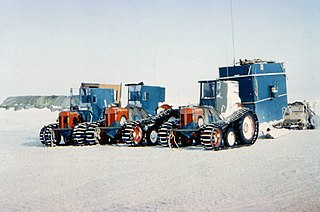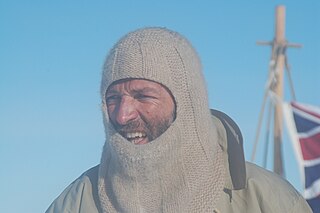Arved Fuchs | |
|---|---|
 | |
| Born | 26 April 1953 Bad Bramstedt, West Germany |
| Occupation(s) | Polar explorer, writer |
| Awards | |
Arved Fuchs (born 26 April 1953) is a German polar explorer and writer.
Arved Fuchs | |
|---|---|
 | |
| Born | 26 April 1953 Bad Bramstedt, West Germany |
| Occupation(s) | Polar explorer, writer |
| Awards | |
Arved Fuchs (born 26 April 1953) is a German polar explorer and writer.


On 30 December 1989, Fuchs and Reinhold Messner were the first to reach the South Pole with neither animal nor motorised help, using skis and a parasail. That made him the first person to reach both poles by foot within one year.
Many of his expeditions have taken place on the water, such as his failed attempt to sail around the North Pole on a traditional sailing boat (1991–1994). This boat, Dagmar Aaen, is still used by Fuchs on his current expeditions.
In 2000, Fuchs led an expedition to recreate Ernest Shackleton's desperate sea journey in the James Caird from Elephant Island to South Georgia, and the subsequent land crossing of that island. [1]
In October 2017, Fuchs was awarded the Order of Merit of the Federal Republic of Germany for his merits to the protection of the environment. [2]

The history of Antarctica emerges from early Western theories of a vast continent, known as Terra Australis, believed to exist in the far south of the globe. The term Antarctic, referring to the opposite of the Arctic Circle, was coined by Marinus of Tyre in the 2nd century AD.

Major Sir Ernest Henry Shackleton was an Anglo-Irish Antarctic explorer who led three British expeditions to the Antarctic. He was one of the principal figures of the period known as the Heroic Age of Antarctic Exploration.

Sir Vivian Ernest Fuchs was an English scientist-explorer and expedition organizer. He led the Commonwealth Trans-Antarctic Expedition which reached the South Pole overland in 1958.

The voyage of the James Caird was a journey of 1,300 kilometres (800 mi) from Elephant Island in the South Shetland Islands through the Southern Ocean to South Georgia, undertaken by Sir Ernest Shackleton and five companions to obtain rescue for the main body of the stranded Imperial Trans-Antarctic Expedition of 1914–1917. Many historians regard the voyage of the crew in a 22.5-foot (6.9 m) ship's boat through the "Furious Fifties" as the greatest small-boat journey ever completed.

The Commonwealth Trans-Antarctic Expedition (CTAE) of 1955–1958 was a Commonwealth-sponsored expedition that successfully completed the first overland crossing of Antarctica, via the South Pole. It was the first expedition to reach the South Pole overland for 46 years, preceded only by Amundsen's expedition and Scott's expedition in 1911 and 1912.

Thomas Crean was an Irish seaman and Antarctic explorer who was awarded the Albert Medal for Lifesaving (AM).

The Imperial Trans-Antarctic Expedition of 1914–1917 is considered to be the last major expedition of the Heroic Age of Antarctic Exploration. Conceived by Sir Ernest Shackleton, the expedition was an attempt to make the first land crossing of the Antarctic continent. After Roald Amundsen's South Pole expedition in 1911, this crossing remained, in Shackleton's words, the "one great main object of Antarctic journeyings". Shackleton's expedition failed to accomplish this objective, but became recognized instead as an epic feat of endurance.

Frank Arthur Worsley was a New Zealand sailor and explorer who served on Ernest Shackleton's Imperial Trans-Antarctic Expedition of 1914–1916, as captain of Endurance. He also served in the Royal Navy Reserve during the First World War.

Tim Jarvis AM is a British-Australian environmental explorer, adventurer, climber, author and documentary filmmaker, with Masters qualifications in environmental science and environmental law. Due to his 2013 expedition recreating the voyage and mountain crossing of Sir Ernest Shackleton, Jarvis is considered an authority on Shackleton and the leadership style he espoused.

The NimrodExpedition of 1907–1909, otherwise known as the British Antarctic Expedition, was the first of three successful expeditions to the Antarctic led by Ernest Shackleton and his second expedition to the Antarctic. Its main target, among a range of geographical and scientific objectives, was to be first to the South Pole. This was not attained, but the expedition's southern march reached a Farthest South latitude of 88° 23' S, just 97.5 nautical miles from the pole. This was by far the longest southern polar journey to that date and a record convergence on either Pole. A separate group led by Welsh Australian geology professor Edgeworth David reached the estimated location of the South Magnetic Pole, and the expedition also achieved the first ascent of Mount Erebus, Antarctica's second highest volcano.

The Shackleton–Rowett Expedition (1921–22) was Sir Ernest Shackleton's last Antarctic project, and the final episode in the Heroic Age of Antarctic Exploration.

James William Slessor Marr was a Scottish marine biologist and polar explorer. He was leader of the World War 2 British Antarctic Expedition Operation Tabarin during its first year, 1943–1945.

The Second German Antarctic Expedition of 1911–1913 was led by Wilhelm Filchner in the exploration ship Deutschland. Its principal objective was to determine whether the Antarctic continent comprised a single landmass rather than separated elements, and in particular whether the Weddell Sea and Ross Sea were connected by a strait. In addition, an extensive programme of scientific research was undertaken. The expedition failed to establish a land base, and the ship became beset in the Weddell Sea ice, drifting north for eight months before reaching open water. The expedition was marred by considerable disagreement and animosity among its participants, and broke up in disarray.
Benjamin John Saunders is an English polar explorer, endurance athlete, and motivational speaker. He led the first return journey to the South Pole on foot via Shackleton and Scott's route in 2013–14, and skied solo to the North Pole in 2004. Saunders has skied more than 3,700 miles (6,000 km) on polar expeditions since 2001. He holds the record for the longest human-powered polar journey in history (2,888 km) and for the longest solo Arctic journey by a Briton (1,032 km).

Farthest South refers to the most southerly latitude reached by explorers before the first successful expedition to the South Pole in 1911.


New South Greenland, sometimes known as Morrell's Land, was an appearance of land recorded by the American captain Benjamin Morrell of the schooner Wasp in March 1823, during a sealing and exploration voyage in the Weddell Sea area of Antarctica. Morrell provided precise coordinates and a description of a coastline which he claimed to have sailed along for more than 300 miles (480 km). Because the Weddell Sea area was so little visited and hard to navigate due to ice conditions, the alleged land was never properly investigated before its existence was emphatically disproven during Antarctic expeditions in the early 20th century.
Major explorations of Earth continued after the Age of Discovery. By the early seventeenth century, vessels were sufficiently well built and their navigators competent enough to travel to virtually anywhere on the planet by sea. In the 17th century, Dutch explorers such as Willem Jansz and Abel Tasman explored the coasts of Australia. Spanish expeditions from Peru explored the South Pacific and discovered archipelagos such as Vanuatu and the Pitcairn Islands. Luis Vaez de Torres chartered the coasts of New Guinea and the Solomon Islands, and discovered the strait that bears his name. European naval exploration mapped the western and northern coasts of Australia, but the east coast had to wait for over a century. Eighteenth-century British explorer James Cook mapped much of Polynesia and traveled as far north as Alaska and as far south as the Antarctic Circle. In the later 18th century, the Pacific became a focus of renewed interest, with Spanish expeditions, followed by Northern European ones, reaching the coasts of northern British Columbia and Alaska.